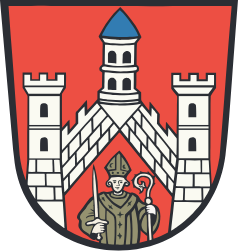Stadt Bad Neustadt a. d. Saale
Rathausgasse 2
97616 Bad Neustadt a. d. Saale
Telefon: 09771/9106-0
Telefax: 09771/9106-109
E-Mail: info(at)bad-neustadt.de
Description
In red a silver crenellated wall rising from the right and left, at the top occupied by a silver round tower with a blue domed roof, at the bottom on both sides a silver crenellated tower; in the triangle below the walls a growing, golden dressed bishop with upright sword in the right and silver crosier in the left.
Meaning
The section of the wall with the three towers is supposed to reflect the medieval city fortifications, and the bishop of the coat of arms represents the prince-bishop as a sovereign with mitre and pluvial.
Date of acceptance of the coat of arms or the first historical illustration
The first known town seals and coats of arms appeared on documents from 1277, 1282, 1294 and 1317 as well as on some other documents, but without an exact date.

Stadt Bad Neustadt a. d. Saale
Rathausgasse 2
97616 Bad Neustadt a. d. Saale
Telefon: 09771/9106-0
Telefax: 09771/9106-109
E-Mail: info(at)bad-neustadt.de
Kurzfassung der Stadtgeschichte
hier klicken
by Dr. Ludwig Benkert
Previous settlement
Pfalz Salz, built in 790 by Charles the Great (exact location unknown).
First mentioning
1232 as an episcopal-würzburg founding city (nova civitas).
Town charter
Originally an episcopal Würzburg official town with a mayor and council of lay assessor (13th century), later mayor with (at times extended) city council (from the 14th century); 1803-06 electoral-Bavarian, 1806-14 grand ducal Würzburg, 1814-1918 royal Bavarian, since 1914 Bavarian municipality.
Oldest preserved town seal: 1267 (fragment), 1282 (complete).
City fortification
Medieval city wall ring almost completely preserved.Hohntor (landmark) 1578/80 newly built.
History
The official town of Neustadt an der Saale, situated at the foot of Salzburg (12th century), was the centre of the Franconian Oberland in the Middle Ages and later. Margarethe Lindemann, the mother of Martin Luther, came from there. During the Peasants' War the town was forced onto the side of the rebels and then severely punished by the episcopal sovereign. During the Counter-Reformation under Julius Echter (1586/87) 90 Protestant families were expelled from the town and the country. The town also recovered only with difficulty from the great losses of people and assets during the Markgräfler War (1553/54) and the 30-year war (especially 1631-48).
Urban development
19th century: Expansion of the railway lines, the commercial and craftsmen's town with its numerous annual and cattle markets experienced a noticeable upswing.
20th century: Settlement of several industrial enterprises (Franconian enamelling and stamping works, the companies Preh, Jopp, Siemens, Forbach, Kunert).
Incorporation, from Bad Neuhaus 1934 since Bad Neustadt, brought a new line of business with the spa, which has developed into an important clinic location in recent years (including a psychosomatic clinic, cardiovascular clinic, neurological clinic, clinic for hand surgery).
Regional reform: 1972-1978 with the incorporation of: Brendlorenzen, Dürrnhof, Lebenhan, Herschfeld, Mühlbach, Löhrieth
literature
Ludwig Benkert: Bad Neustadt. The town chronicle, Bad Neustadt/Creussen, 1985